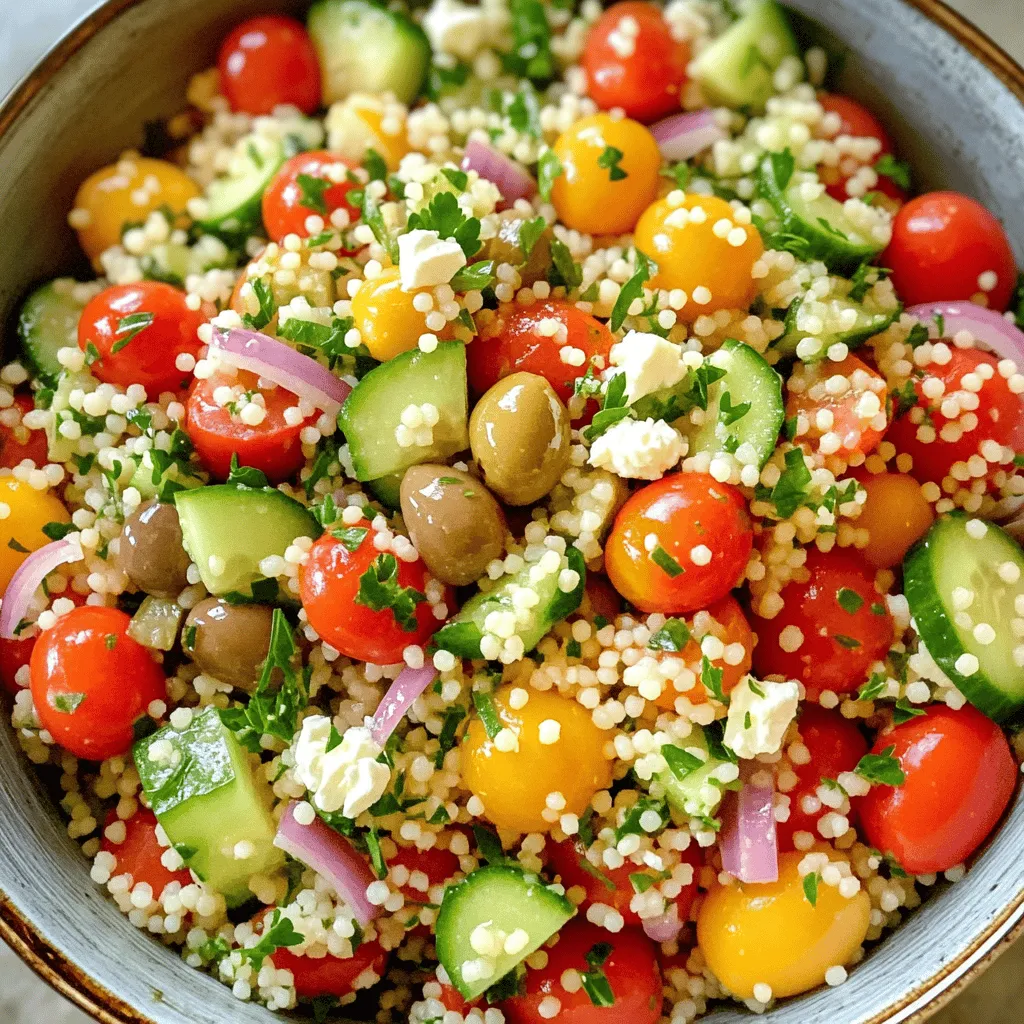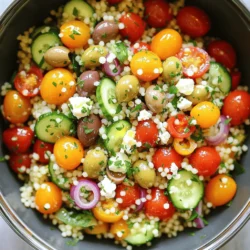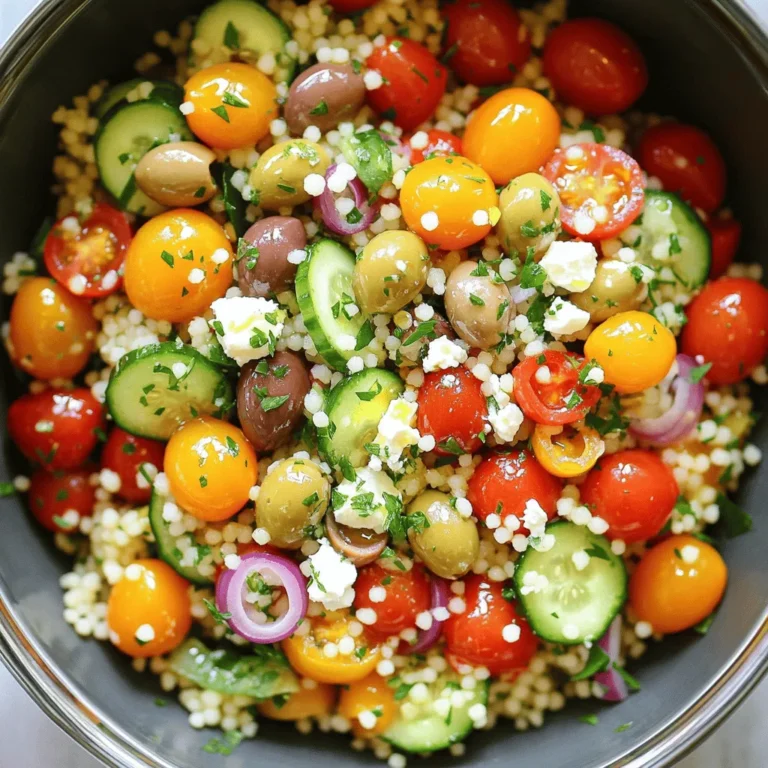Looking to bring vibrant flavors to your table? My Savory Mediterranean Couscous Salad is just the dish for you! With fresh veggies, zesty dressings, and easy steps, this recipe is simple and delicious. Plus, it’s packed with nutrients! Whether you’re meal prepping or hosting guests, this salad fits every occasion. Dive in to discover how to make this tasty dish that everyone will love!
Ingredients
List of Key Ingredients
– 1 cup couscous
– 1 1/4 cups vegetable broth
– 1/2 cup cherry tomatoes, halved
– 1/2 cucumber, peeled and diced
– 1/4 red onion, finely chopped
– 1/2 cup Kalamata olives, pitted and sliced
– 1/2 cup feta cheese, crumbled
– 1/4 cup fresh parsley, chopped
– 1/4 cup extra virgin olive oil
– 2 tablespoons freshly squeezed lemon juice
– 1 teaspoon dried oregano
– Salt and freshly ground black pepper, to taste
Importance of Quality Ingredients
Using good ingredients makes a big difference. Fresh vegetables make the salad bright and tasty. High-quality olive oil adds richness. Feta cheese gives a creamy texture, while Kalamata olives add a salty bite. Each part together creates a balanced flavor. Don’t skip on these; they are key to the dish.
Nutritional Benefits of Each Ingredient
– Couscous: A great source of carbs, giving you energy.
– Vegetable broth: Low in calories, full of flavor.
– Cherry tomatoes: Packed with vitamins A and C, plus antioxidants.
– Cucumber: Hydrating and low in calories, perfect for summer.
– Red onion: Offers heart health benefits and adds natural sweetness.
– Kalamata olives: Good fats that support heart health.
– Feta cheese: Provides protein and calcium, which help bones.
– Fresh parsley: Adds vitamins K and C, and acts as an antioxidant.
– Extra virgin olive oil: Contains healthy fats and antioxidants.
– Lemon juice: High in vitamin C, boosting your immune system.
– Oregano: Has anti-inflammatory properties and is a great flavor.
– Salt and pepper: Enhances taste and helps balance flavors.
These ingredients not only make your salad delicious but also healthy. Enjoy the flavors and the benefits!
Step-by-Step Instructions
Preparing the Couscous
To start, grab a medium saucepan. Pour in 1 1/4 cups of vegetable broth and set the heat to medium-high. Wait until the broth boils. Once it’s bubbling, add 1 cup of couscous. Stir it quickly to keep it from clumping. Cover the pot and take it off the heat. Let it sit for about 5 minutes. This lets the couscous soak up all the broth. After 5 minutes, use a fork to fluff it. Break up any clumps and set it aside to cool.
Mixing the Vegetables
Next, take a large mixing bowl. In it, combine the following ingredients:
– 1/2 cup cherry tomatoes, halved
– 1/2 cucumber, peeled and diced
– 1/4 red onion, finely chopped
– 1/2 cup Kalamata olives, pitted and sliced
– 1/2 cup feta cheese, crumbled
– 1/4 cup fresh parsley, chopped
Toss these ingredients gently to mix them well.
Whisking the Dressing
Now, grab a small bowl for the dressing. Add in:
– 1/4 cup extra virgin olive oil
– 2 tablespoons freshly squeezed lemon juice
– 1 teaspoon dried oregano
– Salt and freshly ground black pepper, to taste
Whisk these ingredients together until they blend nicely.
Combining Ingredients
Once your couscous has cooled a bit, it’s time to combine. Transfer the couscous into the bowl with the veggies. Drizzle the dressing over everything. Use a gentle folding motion to mix all the ingredients. Make sure everything is coated well. After mixing, taste the salad. You can add more salt or lemon juice if you want.
For the best flavor, let the salad sit at room temperature for 15 minutes. This helps the tastes blend together. Enjoy your Mediterranean couscous salad!
Tips & Tricks
Making a Flavorful Couscous Salad
To make a tasty couscous salad, use high-quality broth. The broth adds depth to the dish. I recommend using vegetable broth for a rich flavor. Also, let the couscous cool before mixing. This step keeps the salad from getting mushy. Fresh herbs are key! Parsley brightens each bite and adds freshness. Don’t skimp on the lemon juice either; it balances the flavors.
Common Mistakes to Avoid
One common mistake is overcooking the couscous. Follow the cooking time closely to keep it fluffy. Another mistake is not letting it cool. If you mix it while hot, the veggies can wilt. Be careful with salt too. Feta and olives are salty, so taste before adding more. Lastly, don’t skip the resting time. Allowing the salad to sit helps the flavors blend.
How to Enhance Presentation
Presentation can make your salad pop! Serve it in a large bowl or on plates. A colorful dish is more inviting. Garnish the salad with extra parsley and a sprinkle of feta. You can also drizzle a bit more olive oil on top before serving. This adds shine and flavor. For a fun twist, use small bowls for individual servings. A touch of color and texture will impress your guests.

Variations
Alternative Ingredients for Customization
You can change this salad to fit your taste. Try adding roasted red peppers for a sweet kick. Artichoke hearts can bring a nice briny flavor. For crunch, toss in some toasted pine nuts or sliced almonds. You can also swap feta cheese for goat cheese or even skip cheese altogether. This flexibility makes the salad your own.
Dietary Adaptations (Vegan, Gluten-Free)
If you need a vegan option, just omit the feta cheese. You can replace it with avocado for creaminess. Use vegetable broth instead of chicken broth to keep it vegan. For a gluten-free version, replace couscous with quinoa or rice. Both options work well and keep the salad delicious.
Seasonal Variations
Seasonal ingredients can brighten your salad. In summer, add fresh corn or bell peppers for color. In fall, roasted butternut squash adds a sweet touch. Winter greens, like kale or spinach, can make it hearty. Choose fruits like pomegranates in the fall or citrus in winter for a fresh burst of flavor. Each season offers a chance to reinvent this dish.
Storage Info
Best Practices for Storing Leftovers
To keep your Mediterranean couscous salad fresh, store it in an airtight container. This helps prevent the salad from drying out or absorbing other odors. Place it in the fridge as soon as you finish your meal. If you have leftover dressing, store it separately. It can last longer that way.
Shelf Life of Ingredients
When stored properly, this salad can last up to three days in the fridge. The couscous and veggies hold up well. However, the feta cheese may start to lose its texture after a day or two. To keep things fresh, check for any signs of spoilage before serving.
How to Refresh the Salad
If your salad seems a bit dry after storage, don’t worry. Just add a splash of olive oil or lemon juice to revive the flavors. Toss it gently to mix everything again. This little step will bring back its freshness. You can also add some fresh herbs or extra veggies to brighten it up.
This Mediterranean couscous salad is delightful and easy to prepare.
FAQs
How long does Mediterranean couscous salad last?
Mediterranean couscous salad lasts up to three days in the fridge. Store it in an airtight container. The flavors will blend and improve over time, making it taste even better. Just keep an eye on the veggies. If they start to look sad, it’s time to toss the salad.
Can I prepare it ahead of time?
Yes, you can prepare this salad a day in advance. Just make sure to dress it right before serving. If you dress it too early, the couscous may soak up too much dressing. This can make it soggy. Mixing in the dressing last keeps it fresh and tasty.
What to serve with Mediterranean couscous salad?
This salad pairs well with grilled chicken, fish, or shrimp. You can also serve it as a side with pita bread and hummus. For a lighter meal, enjoy it on its own or with a drizzle of extra virgin olive oil and lemon. It’s versatile and fits many meals.
Can I substitute feta cheese?
Yes, you can substitute feta cheese if you prefer. Try goat cheese or a dairy-free cheese for a vegan option. These alternatives will change the flavor, but they still taste great. Just make sure to adjust the amount based on your choice.
This blog post covered how to create a tasty Mediterranean couscous salad. I shared key ingredients and their health benefits. You learned step-by-step instructions for making it perfect. Tips helped you avoid common mistakes and enhance your dish. Variations allow for personalization and dietary needs. Finally, we discussed storage tips to keep your salad fresh.
Embrace these ideas and enjoy your delicious, colorful salad!


